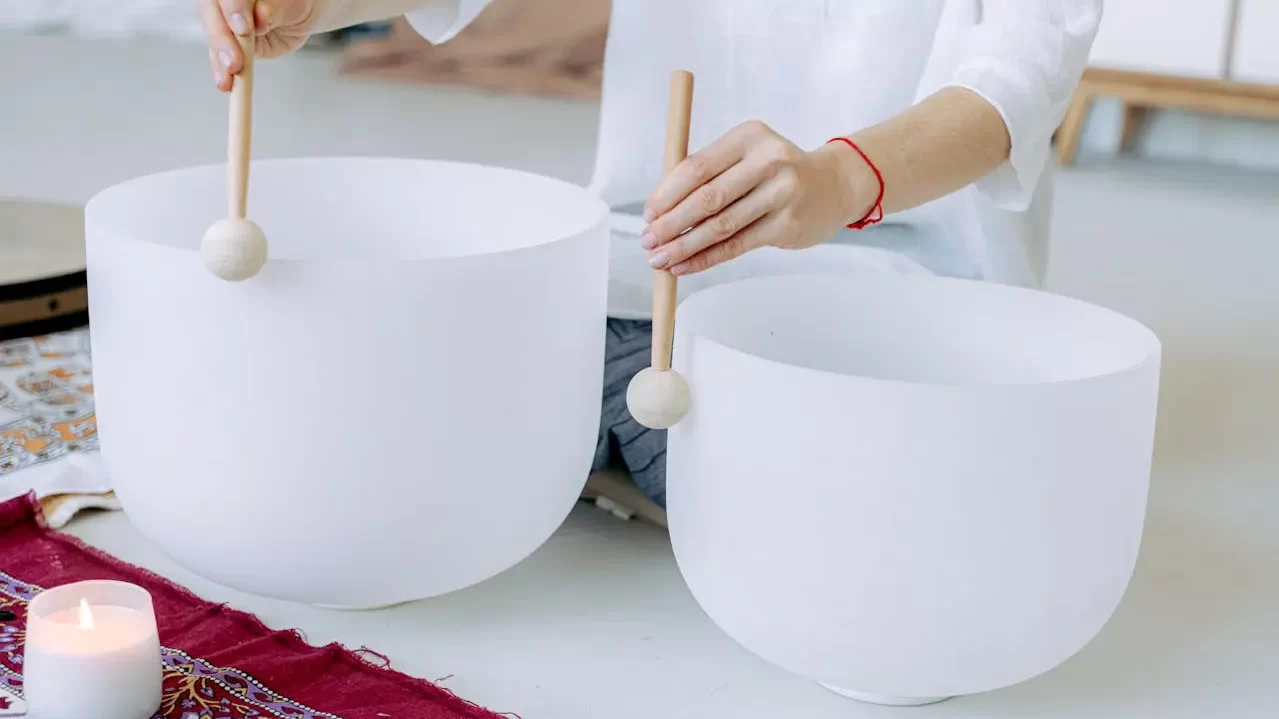
Singing Bowls: What Are They?
Ancient tools for meditation, relaxation, and healing are singing bowls—also called Tibetan singing bowls or Himalayan bowls. Handcrafted to create a distinctive sound, each bowl—made historically from a mix of metals including copper, tin, zinc, iron, silver, and gold—is Played, they have a harmonic, comforting resonance for the listener.
From the Himalayan areas of Nepal, Tibet, India, and Bhutan, singing bowls have a rich cultural legacy spanning more than a thousand years! Buddhist monks and Tibetan Buddhist practitioners first applied them in religious ceremonies, meditation techniques, and healing rites. Singing bowls are appreciated all around today for their spiritual and healing qualities. Every size, form, and material singing bowls are made from affects the quality and nature of the sound created.
The bowl’s distinctive resonance and visual appeal are influenced by metal composition, workmanship, and even bowl age. While some bowls are simple, others are elaborately ornamented with spiritual-meaning symbols and themes. Apart from their conventional application in spiritual and therapeutic approaches, singing bowls have become somewhat well-known in contemporary holistic therapies and well-being.
Sound healing sessions, yoga classes, meditation techniques, and even household settings are among the places they find use in order to foster calm. In the domains of psychology, neurology, and alternative medicine, singing bowls’ therapeutic qualities are becoming more and more well-known and investigated.
How Do Singing Bowls Work?
Singing bowls use striking and friction to generate sound. A mallet’s friction generated as it circles the bowl’s rim causes the bowl to shake. Also producing vibrations is striking the bowl with a mallet. We hear these vibrations as the unique tones of the singing bowl—sound waves.
The sound-producing process depends much on the material, form, and size of the bowl. The bowl’s capacity to withstand vibrations depends on the metal composition employed, for example; the shape determines the distribution of the sound waves.
How Singing Bowls Create Their Unique Sound
A singing bowl will vibrate and those vibrations produce sound waves when you strike or rub it with a mallet. By compressing and decompressing the molecules around them, these waves move across air, water, or even solid things.
This operates as follows: The bowl vibrates with the friction or impact of the mallet. Like ripples in a pond, this vibration generates high and low-pressure waves throughout the surrounding material. Whether via the air or even your body if you’re close enough, the sound then spreads out in all directions.
Your eardrums vibrate when these sound waves get to your ears, and your brain decodes those vibrations as sound. Singing bowls’ unusual form produces a range of tones, therefore providing a rich, layered auditory experience. These sound waves interacting with your surroundings and with you can have a soothing and healing impact. Moreover, the vibrations themselves can enable you to unwind and feel more rooted.
The Science Behind the Results
The theories of sound treatment, brainwave entrainment, and physiological reactions to vibration define the science behind the effects of singing bowls on humans most essentially. Here’s a breakdown of these effects:
- Singing bowls create harmonic tones and vibrations that speak to the body. The body’s sensory system picks vibrations; the auditory system handles these noises. This generates a multi-sensory experience capable of inducing mental state change and relaxation.
- The key mechanism behind the effects of singing bowls is brainwave entrainment. This happens when the bowls’ harmonic tones match brainwave frequencies. For example:
- Beta Waves: Associated with attentiveness and active thought.
- Alpha Waves: Linked to calm, contemplative mood and relaxation.
- Theta Waves: Deep stages of concentration, creativity, and sleep. Singing bowls help the brain enter various states, therefore improving mental clarity, lowering stress, and encouraging inner calm.
- Physiological Impact
- Vibrances enter the body and activate cells, therefore encouraging cellular renewal. This can improve general cellular operation and healing mechanisms.
- Gentle vibrations encourage vasodilation, therefore boosting blood circulation and helping tissues to receive more oxygen and nutrients.
- Sound waves’ soothing action helps to lower muscle tension, therefore relieving physical discomfort and agony.
- Psychological and Emotional Benefits
- Singing bowls’ calming sounds assist ground the mind during meditation therefore facilitating the maintenance of concentration and deepening the contemplative experience.
- Singing bowls’ soothing qualities help to lower cortisol levels, therefore lowering anxiety and stress.
- Singing bowls help in emotional processing and can reduce symptoms of depression and anxiety by establishing a relaxing surrounding.
Research and Evidence
Although singing bowls have long been used traditionally, contemporary scientific studies on their impacts are still in progress. Studies have concentrated on many facets, including how they affect brainwave activities and stress reduction.
Singing bowl meditation dramatically lowered tension and anxiety, according to a study written in the Journal of Evidence-Based Complementary & Alternative Medicine. Following sessions using singing bowls, participants said they felt less stressed and more at ease.
After consistent singing bowl sessions, the same study found increases in mood, less depression, and improved mental clarity.
According to the study, bodily suffering also lessened following sound healing sessions. Those between the ages of 40 and 59 seemed to gain the most, showing the biggest decrease in stress and a marked decrease in physical pain.
Using EEG tracking, another study—published in the June 2023 International Journal of Environmental Research and Public Health —examined the impact of singing bowl sounds on brain wave activity. The sounds from the singing bowls caused a change from beta waves to alpha and theta waves, which are linked with relaxation and contemplative states, the scientists said.
What the Studies Do and Don’t Show
According to the studies already in publication, singing bowls can help with pain management, emotional wellness, cognitive performance, and stress. The consistent results of several research point to singing bowl sounds and vibrations as helping agents for relaxation, anxiety reduction, and general well-being. What the
Many studies on singing bowls have constraints even with their encouraging outcomes. Often small, sample sizes mean that research may lack thorough controls, which makes it challenging to extend results to more significant groups. Furthermore, the placebo effect can be included in participants’ stated advantages since the process of attending a treatment session itself might help them to feel better.
More thorough investigations with bigger sample sizes and better controls are required to completely grasp the processes behind the impacts of singing bowls. Future studies should seek to investigate long-term effects and possible uses in clinical environments as well as separate the particular influence of sound and vibration.
Standard Therapist and Wellness Practices
Using singing bowls, practitioners create sound baths or sessions in which participants sink themselves into the healing vibrations. These sessions seek to improve mental and physical well-being as well as to encourage rest and stress reduction.
Many meditation techniques combine singing bowls to improve concentration and intensify the contemplative experience. The soothing melodies enable a condition of attention and aid to soothe the mind.
Some practitioners of energy healing believe singing bowls help balance the body’s energy centers (chakras). The vibrations are supposed to clear obstacles and encourage the vital energy (qi or prana) to flow over the body.
I go to my preferred practitioner on YouTube when I want to enjoy a private session at home or lack time to make an actual attendance to a session. It’s a handy approach to enjoying the relaxing benefits of singing bowl sessions on my own calendar.
Making The Most of a Sound Bath
Maximizing the advantages of a sound bath solo or with a practitioner requires choosing the appropriate intention and technique:
1. Start by clearly intending your sound bath session. Whether your experience is spiritual connection, stress release, or leisure, defining your objectives will help the experience be more successful.
2. Establish a calm surroundings fit for leisure. Cut the lights, clear distractions, and think about supporting your comfort during the session with cozy blankets or pillows.
3. Pay especially close attention to the singing bowl sounds. Whether you’re listening to records or seeing them live, notice how the vibrations speak to your body and psyche. Let yourself live totally in the moment.
4. Include deep breathing techniques to improve relaxation. To intensify your meditation state and encourage inner peace, synchronize your breathing with the pattern of the sound vibrations.
5. If you practice by yourself, try several methods like striking or rimming the bowl to find what best speaks to you. Let the sound lead your trip inward; trust your instincts.
6. Practitioner Sessions: It’s important to be open to your own experience even in a session run under direction by a practitioner. If you feel comfortable, you can discuss any arising feelings or sensations. trusting their knowledge to enable a transforming and caring encounter.
Finally
More than just lovely sounds, singing bowls give a road toward overall well-being, awareness, and relaxation. Their significant effects on the mind, body, and soul whether applied in meditation, therapy, or just to foster a calm environment. Although years of tradition and anecdotal evidence support their function in fostering health and harmony, scientific study is still exploring their medicinal potential.
Understanding the mechanics of sound generation, the science underlying their impacts, and useful applications helps you to make the most of singing bowls in improving the quality of your life.
References:
- Goldsby TL, Goldsby ME, McWalters M, Mills PJ. Effects of Singing Bowl Sound Meditation on Mood, Tension, and Well-being: An Observational Study. J Evid Based Complementary Altern Med. 2017;22(3):401-406. doi:10.1177/2156587216668109
- Kim S-C, Choi M-J. Does the Sound of a Singing Bowl Synchronize Meditational Brainwaves in the Listeners? International Journal of Environmental Research and Public Health. 2023; 20(12):6180. https://doi.org/10.3390/ijerph20126180



Leave a Reply